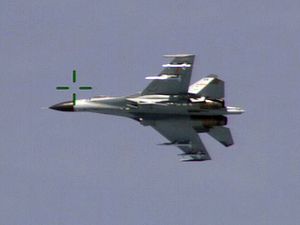On Tuesday, in international airspace over the South China Sea, two Chinese fighter jets flew dangerously close to a U.S. EP-3 Aries signals reconnaissance aircraft. Lt. Col. Michelle Baldanza, a spokesperson for the U.S. Department of Defense, confirmed on Wednesday to NBC News that “two tactical aircraft from the People’s Republic of China” had attempted a dangerous intercept against the U.S. patrol aircraft, coming with 50 feet.
The two aircraft were reportedly J-11 fighters, some of which have been stationed on Woody Island in the Paracel Islands since November 2015. The incident is being further investigated by U.S. Pacific Command.
Contacts between Chinese and U.S. aerial assets in the South China Sea are common occurrences, with fixed procedures; this incident is notable precisely because the U.S. Defense Department is describing it as unsafe, suggesting that the Chinese pilots involved behaved unprofessionally.
Moreover, this isn’t the first unsafe intercept by Chinese fighters against U.S. surveillance aircraft. Similar incidents have taken place in August 2014 and September 2015, most recently. The August 2014 incident took place in international airspace off China’s Hainan Island, in the South China Sea, while the less serious September 2015 incident took place in airspace off the Shandong peninsula.
In 2001, a collision occurred between a U.S. EP-3 Aries and a Chinese fighter jet near Hainan Island. That incident resulted in the death of the Chinese pilot involved, damaged both aircraft, grounding the U.S. EP-3 on Hainan, and spiraled into a major diplomatic crisis.
To prevent a repeat of the Hainan incident, as the 2001 episode came to be known, the United States and China, in November 2014, adopted a memorandum to regulate the “safety of air and maritime encounters” between their militaries. In September 2015, the two countries added a supplement to strengthen the provisions of the joint memorandum.
It may turn out that the behavior of the Chinese pilots in Tuesday’s incident violated the procedures set out in the memorandum, potentially setting back trust between the two countries. So far, the Pentagon has outlined the scope of the incident generally, without assigning culpability. Baldanza’s written statement reportedly noted that “Over the past year, DoD has seen improvements in PRC actions, flying in a safe and professional manner.”
In January 2015, the head of the U.S. and Chinese navies, Admiral John Richardson and Admiral Wu Shengli, had expressed their satisfaction with the multilateral Code for Unplanned Encounters at Sea (CUES), a “non-binding, voluntary agreement to follow certain set procedures for communicating with other military forces encountered at sea or in the air,” as my colleague Shannon Tiezzi had explained after CUES was adopted in April 2014, at the Western Pacific Naval Symposium, by the United States, China, and other regional states.
Indeed, despite increased tensions in the South China Sea between the United States and China amid increasingly regular FONOPs, military-to-military communications have generally been good and cordial. Tuesday’s unsafe intercept will cast a pall over that record, raising tensions between the two countries.
The incident comes days after the U.S. Navy’s most recent freedom of navigation operation (FONOP) in the South China Sea and the U.S. Department of Defense released its annual assessment of China’s military capabilities.
Though the report is an annual occurrence, the Chinese government reacted angrily, with the foreign ministry suggesting that the Pentagon had “deliberately distorted” facts and “severely damaged mutual trust between the two sides.”
The incident also comes as regional states and the United States eagerly await the decision of the Hague-based Permanent Court of Arbitration on the merits of the Philippines’ case against China over its maritime claims in the South China Sea.

































